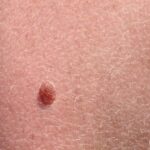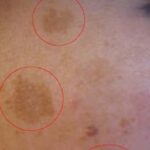What are Moles?
Moles are clusters of pigmented cells that often appear as small, dark brown spots on the body. However, moles can come in a wide variety of colors, shapes and sizes.
Some people are born with moles while the majority will develop between 10 and 40 moles throughout life. New moles appear into mid-adulthood, although some may not appear until later.
Moles, having a life cycle of 50 years, will slowly disappear as they age while others may become raised from the skin and eventually fall off or are rubbed off.
The majority of moles are harmless. But some moles, ones that act or look differently from other existing moles, must be of concern. Monitoring these types of moles is an important step in the diagnosis of malignant melanoma, the most deadly form of skin cancer.
Signs and Symptoms
Moles, typically a small brown spot, can be flesh-colored, pink, light tan to brown, reddish-brown, medium to dark brown or blue to black. Varying in shape from oval to round, moles can be small or large, flat or raised, with or without hairs, mottled or evenly colored, smooth or wrinkled.
Hormonal changes, pregnancy and birth control pills may cause moles to become darker and larger.
Causes
Melanin, a natural pigment that gives skin its color, is usually distributed evenly to the surface cells of skin. However, sometimes these skin cells grow together in a cluster, developing moles.
While moles do not serve a purpose and require no special care, some people have unusual looking moles that are more likely to turn cancerous.
Moles having a risk of becoming cancerous:
Large moles present at birth. The moles that are more than the size of an adult open palm pose the greatest risk.
Moles that run in families. Moles that tend to be hereditary are irregular in shape and are larger than the diameter of a pencil eraser.
Numerous moles. Many moles larger than a pencil eraser.
Seek Medical Advice
See your doctor if a new mole appears past age 20.
Seek medical advice if a mole is painful, itching or burning, oozing or bleeding, inflamed, scaly or crusty, suddenly different in size, shape or elevation.
Screening and Diagnosis
Making a skin examination regularly is the best preventive medical care. Every three years for people ages 20 to 39, and yearly for people age 40 and older.
Your doctor will examine every inch of your body and may take a biopsy (sample of tissue) if he or she suspects a mole to be cancerous.
Treatment
If a mole is found to be cancerous, the entire mole and some of the normal tissue around it will be removed.
Cosmetically, moles can be removed in several ways in a doctor’s office, taking only a short time:
Shave excision. Area around the mole is numbed and a small blade is used to shave off the mole close to the skin.
Punch Biopsy. A small cookie-cutter-like device is used to remove the mole with a small incision.
Excisional Surgery. The mole and a surrounding margin of healthy skin are cut out.
Prevention
Become familiar with the location and pattern of your moles. Have skin examinations regularly. Do not forget to check areas that are not exposed to sunlight.
Use the A-B-C-D skin self-examination guide, adapted from the American Academy of Dermatology:
A is for asymmetrical shape. Moles with irregular shapes.
B is for irregular border. Moles with irregular, notched or scalloped borders.
C is for changes in color. Growths that have many colors or an uneven distribution of color.
D is for diameter. Growths that are larger than the diameter of a pencil eraser.
Self-Care
Other protective measures:
Avoid peak sun times. Avoid overexposure to the sun. Stay out of the sun from 10 a.m. to 4 p.m.
Use sunscreen. Apply sunscreen with a SPF of at least 15.
Cover up. Wear broad-brimmed hats, long sleeves and other protective clothing to avoid overexposure to the sun.







